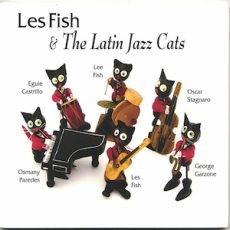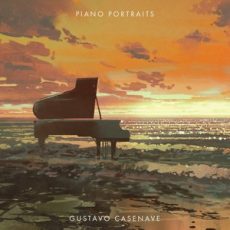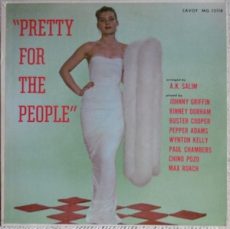
Daily Dose Of Jazz…
Les Fish was born on November 24, 1955 in Boston, Massachusetts. As a teenager in the 1970s he was into rock and played guitar in various bands throughout the greater Boston area. He performed jazz-rock influenced original compositions in shows from the North Shore to Cape Cod.
Enrolling at Berklee College of Music, Fish studied and formed his own jazz fusion group, and made money splitting his time between teaching guitar, nightclub gigs and recording jingles for local television stations. After Berklee and studying with jazz guitar greats Mick Goodrick and Barry Galbraith, he met his future wife Lori Starr and formed the band Amante.
Touring full time for eighteen years with Amante, they worked at top hotels around the world and still performs throughout New England. The inspiration for the recording, Les Fish and The Latin Jazz Cats came three years ago, when he was touring in Cuba.
Returning from Cuba, Les returned home to seek out the best musicians to transfer his vision into reality.. At Berklee he recruited two-time Latin Grammy winning bassist Oscar Stagnaro, saxophonist George Garzone, pianist Osmany Paredes, his son Lee on drums and percussionist and bandleader Eguie Castrillo.
He has performed with many artists including Tito Puente, Arturo Sandoval, Steve Winwood, Danilo Perez, Warren Wolf, Gary Burton, Julian Lage, John Ellis, David Gilmore and Ryan Scott, among others. Guitarist Les Fish continues to perform and record.
More Posts: bandleader,guitar,history,instrumental,jazz,music

Daily Dose Of Jazz…
Gustavo Casenave was born on November 10, 1971 in Montevideo, Uruguay where he studied classical piano from age 6 with Maestro Hector Tosar, who was Aaron Copland’s student. He led the group Kongo Bongo and recorded two albums, however, following a conversation with Hugo Fattoruso he decided to study in Boston, Massachusetts. In 1994 received a full scholarship from O.A.S. to study at the Berklee College of Music and two years later he graduated magna cum laude.
During this period he was awarded the Professional Music Achievement, and his composition Fragiltimer for the Past Future for piano was selected as one of the ten best original compositions coming out of Berklee in the last 30 years, 1966-1996. In 1995 he was accepted as a private student by the legendary jazz vibraphonist Gary Burton.
1997 saw Gustavo settling in New York City and creating a name for himself. He has been awarded three Grammys as a producer, composer and performer, Best Latin Jazz Album (producer), Best Tango Album, and Best Instrumental Album that showcased his ability to create compositions that resonate with audiences worldwide. He has also had six Latin Grammy nominations and three nods for Best Contemporary Classical Composition.
As an educator, Casenave has held positions as Jazz Department Director at the Harbor Conservatory for the Performing Arts and has conducted Tango Master Classes as well as being a guest artist lecturer at The Juilliard School, Yale University, Eastman School of Music, Oberlin Conservatory and Indiana University.
Pianist Gustavo Casenave continues to contribute to jazz as a performer, composer, educator, and scholar, having published his first music theory book, “The Harmonic Structure Levels.
More Posts: bandleader,composer,educator,history,instrumental,jazz,music,scholar

Daily Dose Of Jazz…
Mark Finkin was born to deaf parents in New York City on October 9, 1949 and has been making music since he was five. He started playing at Carnegie Hall at the age of seven and went on to study at Music and Art High School in New York City and later went on to the Midwest to study at The College of Emporia for music. He moved to Maui, Hawaii where he studied composition and piano at The Atlantic University.
Returning to New York City after several years on the island, he recorded with Boris Midney, a Soviet alto saxophonist who took Mark and his group Windmill under his wing. Performing in the New York, New Jersey area he relocated to Florida. While in Florida he honed his craft and recorded and performed with Music of the Spheres who fused laser light and sound to the Miami Space and Transit Planetarium.
Once again Mark returned to New York to settle in Saratoga Springs where he has been performing in and around the Capital district. He has played with Barry Manilow, Alexis Cole, Sherry Saba, Michael Panza, Larry Levine, Mike Wick, Sharron Edwards and Ron Mayfield to name a few.
Finkin’s talent lies beyond jazz as he has written the music for the local production of Popeye Canfield, is the pianist for the inspirational Christian group Revealer, and has played piano at The Lodge in Saratoga Springs for the last six years during the Saratoga, New York racing season.
Pianist Mark Finkin continues to perform, compose and record with Las Manos and his daughter Alexis Cole.

Daily Dose Of Jazz…
Dieter Antritter was born in Pforzheim, Germany on October 6, 1929. After the end of World War II he started first to learn guitar, then later he switched to soprano saxophone. A move to Stuttgart, Germany gave him the opportunity to connect with the local jazz-scene.
On holiday in Paris, France in 1949, he unsuccessfully attempted to meet Sidney Bechet. However, Dieter eventually met Charles Delaunay, who opened him to the possibility of jamming with contemporary jazz greats living in Paris that time. Improving his playing, he built up a network with a few well-known jazz musicians.
Returning to Stuttgart in 1952 he founded the Latin Jazz Band. He used his concerts as a platform for guest musicians from his Paris connection to perform. From this band the Quartier Latin Jazz Band emerged, which existed until at least 2009. During those years this band accompanied numerous guest soloists such as Michel Attenoux, Peanuts Holland, Mezz Mezzrow, Benny Waters and Nelson “Cadillac” Williams.
In 1960, this led to several recordings for Deutscher Schallplattenclub, all recorded in Stuttgart venues. Antritter was one of the world’s longest-serving bandleaders, who led his band for 63 years, from 1952 until his death in 2015.
Bandleader, soprano and alto saxophonist Dieter Antritter died on August 5, 2015 in Königsbach-Stein, Germany.
More Posts: bandleader,history,instrumental,jazz,music,saxophone

Daily Dose Of Jazz…
Francisco “Chino” Pozo was born on October 4, 1915 in Havana, Cuba. An autodidact on piano and bass, he concentrated on bongos, congas, and drums before leaving his home for greener pastures. Moving to the United States in 1937, he played with Machito from 1941–43 and with the Jack Cole Dancers from 1943-1949.
In the Fifties he went on to play in numerous jazz ensembles, especially latin jazz and Afro-Cuban jazz. He performed and/or recorded with Jose Curbelo, Noro Morales, Tito Puente, Tito Rodríguez, Enric Madriguera, Perez Prado, Josephine Premice, Tadd Dameron, Charlie Parker, and Dizzy Gillespie.
He toured with Peggy Lee in 1954-55 and played with Stan Kenton in 1955, Herbie Mann in 1956, Xavier Cugat and René Touzet in 1959.
He also recorded with Illinois Jacquet, Phineas Newborn, Gábor Szabó, Paul Anka, Justo Betancourt, Harry Betts, Fats Navarro, Eddie Palmieri, Johnny Richards, A. K. Salim, Billy Taylor, Clark Terry, Chico O’Farrill, Julius Watkins and Charlie Rouse.
Drummer Chino Pozo, whose claim to be the cousin of Chano Pozo has been disputed, died on April 28, 1980 in New York City.
More Posts: bass,bongo,conga,drums,history,instrumental,jazz,music,piano



